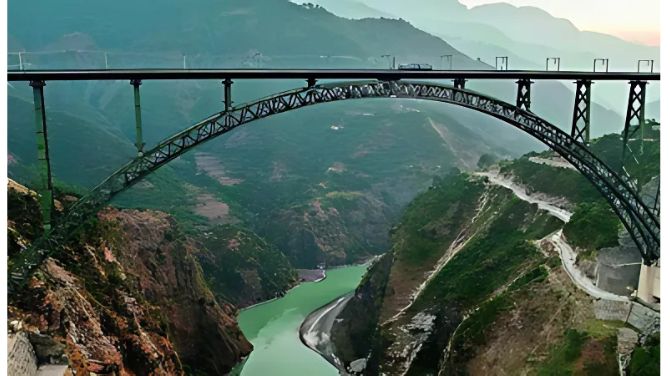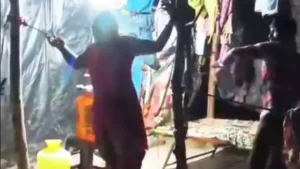PM Modi Unveils World’s Tallest Chenab Rail Bridge, Transforming Connectivity in Jammu and Kashmir
4 min read
Katra, June 6, 2025 – Prime Minister Narendra Modi today inaugurated the Chenab Railway Bridge, the world’s highest railway arch bridge, soaring 359 meters above the Chenab River in Jammu and Kashmir. This monumental achievement, part of the transformative Udhampur-Srinagar-Baramulla Rail Link (USBRL) project, marks a historic milestone in India’s infrastructure journey, promising seamless rail connectivity between the Kashmir Valley and the rest of the nation. The event, held in Katra, also saw the launch of infrastructure projects worth over ₹46,000 crore, aimed at boosting connectivity, tourism, and socio-economic development in the region.
Historical Context: A Vision Realized
The Chenab Railway Bridge is a pivotal component of the USBRL project, a decades-long endeavor to integrate Jammu and Kashmir into India’s railway network. Conceived in the 1990s, the project has navigated significant challenges, including the region’s complex topography, seismic vulnerabilities, and harsh weather conditions. With an investment of approximately ₹43,780 crore, the USBRL spans 272 kilometers, featuring 36 tunnels covering 119 kilometers and 943 bridges. The Chenab Bridge, a symbol of engineering excellence, fulfills a long-standing vision of reliable, all-weather rail access to the Kashmir Valley.
This inauguration holds added significance as it marks Prime Minister Modi’s first visit to Jammu and Kashmir since Operation Sindoor, a military operation launched in response to the April 2025 Pahalgam terror attack, which claimed 26 lives. The event underscores the government’s commitment to fostering peace and progress through transformative infrastructure.
Key Highlights of the Chenab Bridge and Associated Projects
1. An Engineering Marvel
The Chenab Railway Bridge, towering higher than the Eiffel Tower, spans 1,315 meters and is designed to withstand extreme conditions, including seismic activity in a high-risk zone and wind speeds of up to 266 km/h. Constructed with blast-resistant steel and concrete, the bridge sets a global benchmark for safety and durability, reflecting India’s advancements in high-altitude infrastructure.
2. Revolutionizing Connectivity
As a cornerstone of the USBRL project, the Chenab Bridge will drastically reduce travel time between Katra and Srinagar to approximately three hours via Vande Bharat Express trains. This reduction of 2-3 hours will enhance accessibility for residents, pilgrims visiting Shri Mata Vaishno Devi, and tourists exploring the scenic Kashmir Valley, while also facilitating faster movement of goods.
3. Anji Bridge: A Pioneering Addition
Alongside the Chenab Bridge, PM Modi inaugurated the Anji Bridge, India’s first cable-stayed railway bridge. This structure, built in the region’s challenging terrain, complements the USBRL project by ensuring robust connectivity across difficult landscapes.
4. Comprehensive Infrastructure Development
The Prime Minister’s visit included the launch of multiple projects worth over ₹46,000 crore, aimed at transforming Jammu and Kashmir’s infrastructure:
- Road Enhancements: Upgrading the Rafiabad-Kupwara stretch on NH-701 and constructing the Shopian bypass on NH-444 to improve connectivity, particularly in border areas, with an investment of over ₹1,952 crore.
- Srinagar Flyovers: New flyovers at Sangrama Junction (NH-1) and Bemina Junction (NH-44) to ease traffic congestion and improve urban mobility.
- Healthcare Milestone: The foundation stone for the Shri Mata Vaishno Devi Institute of Medical Excellence, a ₹350 crore project that will establish Reasi district’s first medical college, enhancing healthcare access for local communities.
5. Socio-Economic Transformation
The USBRL project, with the Chenab and Anji bridges at its core, is set to reshape Jammu and Kashmir’s economic landscape. By enabling year-round rail connectivity, the project will boost trade, create employment opportunities, and promote tourism. The introduction of Vande Bharat trains between Katra and Srinagar will further enhance spiritual tourism, making pilgrimages and travel more efficient and comfortable.
On the Ground: Voices of Pride and Progress
During his visit, PM Modi engaged with engineers, workers, and officials who played a pivotal role in the USBRL project’s execution. Addressing the gathering, he said, “The Chenab Bridge is a testament to India’s ingenuity and determination. It will not only connect places but also hearts, bringing the people of Jammu and Kashmir closer to opportunities across the nation.”
Jammu and Kashmir Chief Minister Omar Abdullah, who joined the Prime Minister at the event, emphasized the project’s transformative potential: “This is a proud day for our region. The USBRL project will unlock new possibilities for economic growth, tourism, and integration with the rest of India.”
Railway Minister Ashwini Vaishnaw and Union Minister Jitendra Singh also attended, highlighting the collaborative effort behind this milestone. An exhibition showcasing the USBRL project’s journey was a key feature of the event, underscoring the technical and logistical feats achieved.
A Bright Future for Jammu and Kashmir
The inauguration of the Chenab and Anji bridges marks the culmination of a 30-year effort to bring reliable rail connectivity to the Kashmir Valley. With the Vande Bharat trains now operational, the region is poised for a surge in tourism, trade, and economic activity. The broader infrastructure initiatives, including road upgrades and healthcare advancements, reflect a holistic approach to development, ensuring that progress reaches every corner of Jammu and Kashmir.
The Chenab Railway Bridge stands as a towering symbol of India’s ambition and resilience, bridging not just geographical divides but also aspirations for a more connected and prosperous future.





